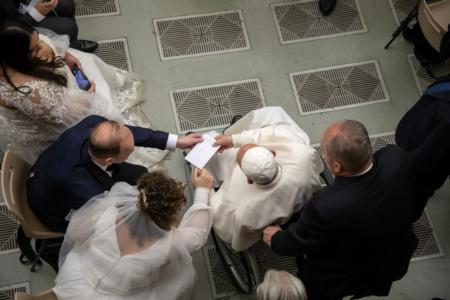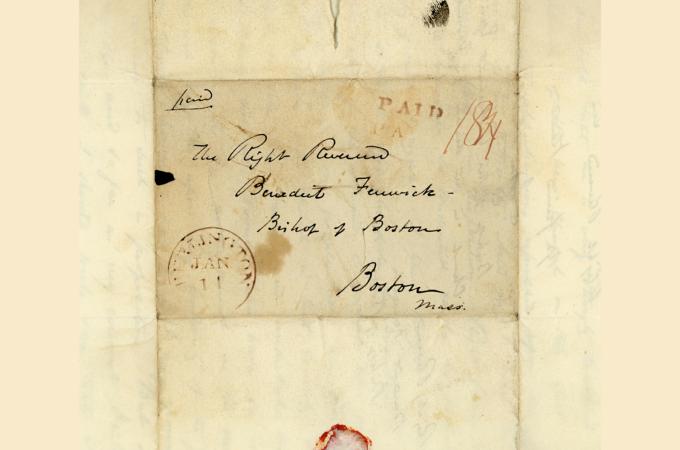A new Catholic church for Burlington, Vermont
On Dec. 30, 1840, John M. Hopkins, bishop of the Protestant Episcopal Diocese of Vermont, penned a letter to Bishop Benedict J. Fenwick of the Diocese of Boston. The subject of the letter was the proposed construction of a new Catholic church in Burlington, Vermont. "I call your attention," he wrote, "to a matter which I think important to the comfort and satisfaction of the Roman Catholic Church in this village, as well as the Church which is under my own pastoral care."
At the time the letter was written, the Catholic Diocese of Boston was expansive, encompassing all New England, yet it was also small in terms of the number of its parishes, priests, and laypeople. It was not unusual for Bishop Fenwick to deal personally with administrative issues as they arose. The letter from Bishop Hopkins merited his careful attention, since it concerned the only extant Catholic parish in Vermont, St. Mary in Burlington.
In July of 1830, Bishop Fenwick had sent Father Jeremiah O'Callaghan, a zealous priest from County Cork, Ireland, to minister to the more than 1,000 estimated Catholics living in the state of Vermont. Father O'Callaghan had traveled the state, saying Masses, conferring sacraments, and providing pastoral care in private homes and rented public spaces. In 1832, he constructed the first Catholic church in Vermont on the grounds of what is now Mt. St. Joseph Cemetery in Burlington. The church was dedicated to Mary later that year, on the feast day of her Nativity, Sept. 8.
The first church of St. Mary would not stand long. The 1830s were a time of extreme and widespread anti-Catholic sentiment in New England. Hostilities and suspicion toward Catholics were encouraged by the rhetoric of popular traveling preachers, such as Lyman Beecher and Horace Bushnell, and by best-selling libelous books, such as Maria Monk's "Awful Disclosures of the Hotel Dieu Nunnery in Montreal." Antipathy toward Catholics could and did stir people into frenzied violence. In 1834, an anti-Catholic mob burned the Ursuline Convent in Charlestown, Massachusetts, to the ground. Four years later, Father O'Callaghan's church would meet the same fate.
On the night of May 9, 1838, St. Mary in Burlington was set on fire. Although no one was harmed, Father O'Callaghan reported that the building was "reduced to ashes... no particle of the edifice, or any of its contents is saved." The Burlington Free Press reported, "There is not a doubt but that it was the work of an incendiary, as no fire had been used in the building for several days." A town committee was convened to investigate the fire, but none were ever charged with having participated in the destruction of St. Mary.
Rather than succumb to fear or intimidation, Father O'Callaghan and his congregation resolved to build a larger, more visible St. Mary Church in downtown Burlington. Within months, they had purchased a lot of land at the corner of Cherry Street and St. Paul Street. The land, O'Callaghan reported to Bishop Fenwick, "gives general satisfaction here, excepting to some Episcopal and Calvinists, who would rather it were chosen in the background." This group, the priest reported, "Take good care to place their meeting-houses, banks, taverns, court houses, etc. in the heart of the village... but they would advise us to settle the Church of Christ out of sight."
The letter that the Episcopal Bishop, John M. Hopkins, sent to Bishop Fenwick gave the other side of the story. It was not, the bishop wrote, out of anti-Catholic prejudice that he opposed the construction of the church in downtown Burlington. Instead, he worried that the Catholic Church was to be constructed "too near to the Prot. Episcopal Church which is under my care," referring to the Episcopal Church of St. Paul, located just two blocks away from the proposed site.
Bishop Hopkins argued that such proximity could only lead to conflict. "In the summer, especially," he wrote, "when the windows are open, the proximity will be found so close as to be a subject of lasting regret." To Hopkins, the idea of this arrangement was so unacceptable that he offered to sell the church of St. Paul to the Catholic Church, and to move his own congregation elsewhere if the Catholics were determined to move to downtown.
Whether Bishop Fenwick mediated between Bishop Hopkins and Father O'Callaghan is unknown, but the second Church of St. Mary was constructed as planned on Cherry Street in 1841, and St. Paul Episcopal Church remained open. Eventually, both churches became cathedrals, the seats of their respective dioceses in Vermont.
VIOLET HURST IS AN ARCHIVIST FOR THE ARCHDIOCESE OF BOSTON.


















